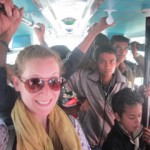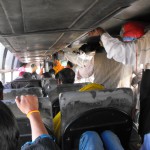When travelers come to India, they have different modes of transportation to get themselves around. The most frequently used are the tuk tuks, or rickshaws, and the trains. The tourists more used to traveling in some kind of comfort will choose to fly or hire drivers for their trek around the country.
For me and my fellow interns living here in India, specifically Jodhpur, we generally choose to take the public transportation instead of the more costly options. Due to this, however, our travel time increases, as well as our stress levels. I have talked with the other Americans that work through the same organization as I do, and we have all at some point or another ended up crying on the bus or tempo… Just bad days get heightened when Indians bombard you on the public transportation system.
There are many options to get around the city and surrounding outlying areas: buses, small buses, tempos, or rickshaws. These are just the cheaper options of course and those that are available to people like myself in Jodhpur. The bus routes are numerous and catching the right bus can sometimes be tricky, but most go to specific areas that you can ask for (that is if they understand what you are trying to say). I always take the rural bus from my village to the city and always prefer to sit on top of the bus because the bus is always overflowing with people and there is nothing like the fresh air breezing by you while you have the best view of the surrounding areas. This bus and the larger of their kind are government run buses that pile in as many people in as possible. I don’t mean three people to two seats; I mean in a bus with seats for around 30 people, there are usually around 50 people piled in whether they are sitting or standing. The trick is to get to the spot where they let people on first, that way you can ensure that you have a seat. Next, always get a window seat. When you are on a bus with 50 plus Indians, for a minimum of an hour, all you want is some fresh air, flowing through the ram-shackled windows, washing over you as you pummel down the dirty roads. The best thing though, and it never fails, is when someone, and sometimes two people, turn on Hindi or Rajasthani music on their cell phone so they can break the silence. India is a very loud country, I don’t know if anyone truly enjoys silence here.
The same goes for the buses in the city. On an average day, you will see every bus at the busy hours over flowing with people, and when you think no one else can possibly squeeze in, you will see an old lady get in and miraculously disappear into the mass of people. Tempos are also very common to see in the city. These are rickshaws that are a little bit bigger and generally have two long seats in the back and one in the front. While these would comfortably fit 8 people in any Indian circumstance, these, too, will be piled in where you cannot figure out how many people are actually there until they pile out like a clown car. Even a few people will hang on the back and jump down at their location if they are brave enough.
Paying for the bus is never over 10 rupees to get around Jodhpur, which is the equivalent of $0.20 and I pay 20 rupees to get from the village into Jodhpur. You can’t beat these kinds of prices, especially when tourists pay 1000 rupees ($20) to get to Jodhpur from the hotel in Chandelao. The fact that I do not make money while I am here in India means that I do not like to spend a large sum of money for anything.
Some people use rickshaws but for those who are not on a time crunch and know which bus to get on, it’s just better to get on a bus. The rickshaws are more expensive and wasteful. Foreigners have a hard time getting a good price on the rickshaws. If one does not know how to bargain or how much the ride should be, the driver will ask for at least double what it should be, if not more. Because I live in Jodhpur, well at least close, I know my way around and how much the price should be, but if I decide on the rickshaw, I still have a problem getting the proper price. The curse of being a white foreigner in India…
It is quite funny being here for over 6 months already because the bus drivers know Emily, the other longer-term intern in Jodhpur, and me. In the city, there are certain routes that know Emily very, very well while all the bus drivers and conductors from the rural village area know me very well. I generally hear people talking about me on the bus and there are always plenty of people who know my name and what I am doing in Chandelao and they will tell the curious new comer. I do dread having to ride the bus in most instances though because people never cease trying to talk with me, even if we can’t effectively communicate with each other. When they realize that I can’t understand them, they just start yelling at me and repeating the same foreign sounds to me. They don’t realize that if you yell at me I still won’t understand. I am not deaf; I just don’t speak the same language.
Now then, if you want a realistic representation of how the bus is, and what the village is like that I live in, watch the Darjeeling Limited. This Wes Anderson film was actually filmed in Jodhpur, Rajasthan, nowhere close to Darjeeling, and even has some parts in a rural village very similar to the one I live in. The rural bus featured in the movie is almost identical to the one that has become my weekly ride.

